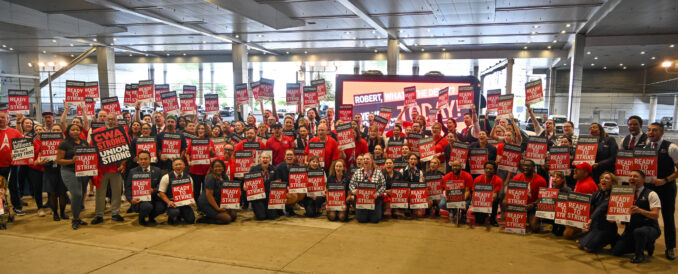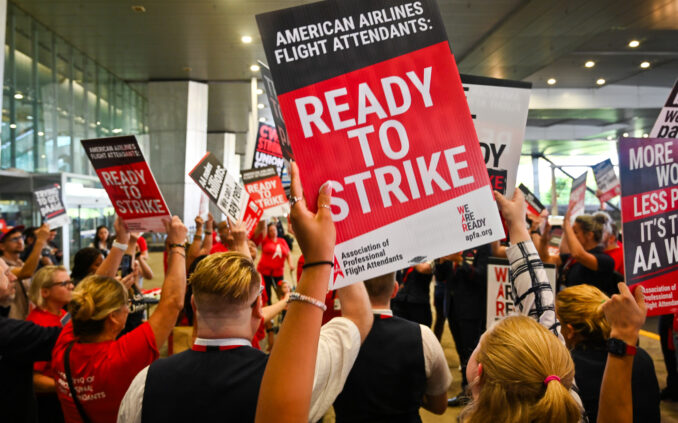Flight attendants prepare to fight
Following the announcement that 99.47% of American Airlines (AA) flight attendants across the U.S. voted to authorize a strike if company officials fail to agree to a 35% wage increase, workers outside Philadelphia Airport’s Terminal A West on Aug. 30, jumped up and yelled in unison, raising and waving their picket signs that said it all: “Ready to Strike!”

Flight attendants and supporters at Philadelphia airport, Aug. 30, 2023. (Credit: Joe Piette)
Members of the Association of Professional Flight Attendants, who haven’t had a wage increase since 2019, also picketed in front of over nine airport terminals from Los Angeles’ LAX to Boston’s BOS on the same day. The vote and widespread picketing “made it clear to American management that we are fired up, unified, and standing together for a contract with significant improvements to compensation, retirement, scheduling flexibility, and more.
“This strong strike authorization vote is a powerful tool necessary to reach an agreement,” read a statement from the APFA Negotiating Committee. (tinyurl.com/mvt8af45) APFA union officials, representing 26,000 flight attendants, are scheduled to sit down with federal mediators in September in Dallas, Texas for more talks.
Demands reflect pandemic, inflation hits on workers’ lives
Management cut onboard staffing levels during the COVID-19 pandemic. Even though the number of flights have since increased and travel demands are surging, AA hasn’t returned to pre-pandemic staffing on its planes. The union is demanding AA agree to beef up onboard staffing numbers so flight attendants are not so overburdened.
The union also demanded that management enable flight attendants to “retire with dignity” by boosting its 401(k) match and contribution. Other initial demands can be found on the union’s website: tinyurl.com/4ucxh6yb.

Flight attendants raise signs supporting strike, Philadelphia, Aug. 30, 2023. (Credit: Joe Piette)
The flight attendants want a contract as good as the one the AA pilots, represented by the Allied Pilots Association, approved by a 72% vote in August. In their new contract, they get immediate raises of 21% with compensation increasing to more than 46% over the duration of the four-year contract, including 401(k) contributions. They will be due a 5% raise in 2024, followed by 4% in 2025 and 2026, followed by a 3% increase in 2027.
APFA militancy amid revitalized labor movement
In industries covered by the Railway Labor Act, federal regulations hostile to labor unions require mediators to rule that there is no point to further negotiations before mediators give the go-ahead for a strike. A 30-day cooling off period is then required. Additionally, the president or Congress can step in and block or delay a work stoppage.
However, the flight attendants’ willingness to strike for their rights takes place at a time when 88% of young workers in the U.S. support labor unions, according to @GBAOStrategies. The pro-union sentiments of most workers can be seen on the streets and in workplaces in many U.S. cities. Workers at unorganized shops, such as Starbucks, Amazon, Jollibee and other corporations are fighting for union recognition and contract agreements are at the highest rate in decades.
Encouraged by an unprecedented contract victory by Teamsters at UPS, 97% of workers in the United Auto Workers voted to authorize a strike. The union’s demands include a 46% wage increase, restoration of traditional pensions for all workers, return of the cost-of-living allowance, reducing the workweek to 32 hours from 40 and increasing retiree pensions.
The Writers Guild of America has been on strike since May and their siblings in SAG-AFTRA have been on strike since July 14 against the Alliance of Motion Picture and Television Producers.
The unions that include entertainment industry writers, actors, dancers, DJs, puppeteers, recording artists, singers, stunt performers, voiceover artists and other media professionals are calling for a retroactive 11% wage increase, improved working conditions, fair compensation from the use of streaming platforms and protections against the use of generative AI to replace working actors and writers.
Taken altogether, the militancy seen at so many work sites, including by flight attendants, points out the obvious: Workers are ready and willing to strike for their rights!

